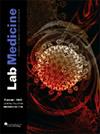异丙酚减轻缺氧-复氧诱导的人近端肾小管上皮细胞损伤
IF 1
4区 医学
Q4 MEDICAL LABORATORY TECHNOLOGY
引用次数: 11
摘要
我们进行了一项研究,以确定异丙酚预处理是否可以保护人近端肾小管上皮(HK-2)细胞免受缺氧-再氧化损伤,以及p38丝裂原活化蛋白激酶(p38MAPK)的作用。方法HK-2细胞随机分为5组:对照组(Con);1组处理1小时,用300 μM CoCl2正常培养基培养24小时,再用无血清培养基刺激(CoCl2组);一组HK-2细胞经5μg/mL−1异丙酚预处理1 h后作为组(Pro组);一组用10%脂质内90 μL CoCl2预处理HK-2细胞1次(Int组);h,然后作为CoCl2组和用异丙酚预处理HK-2细胞1小时的组,10 μmol/L−1SB203580 (p38MAPK抑制剂),同时加入300 μM CoCl2,然后用正常培养基培养24小时(SB组)。采用MTT法和流式细胞术检测HK-2细胞的增殖和凋亡,采用逆转录-聚合酶链反应法研究Bcl-2和caspase-3 mRNA的调控;Western blot检测p38MAPK的表达。结果5 μg/mL−1异丙酚预处理后,HK-2细胞增殖增强,凋亡减少(P <0.05或0.01)。脂质内对HK-2细胞无影响,Bcl-2基因表达上调,caspase-3基因表达下调。同时,异丙酚预处理后p38MAPK表达上调。SB203580可逆转上述规律(P <0.05或0.01),而Int组与CoCl2组间无差异。结论5μg/mL−1异丙酚预处理在临床相关浓度下可调节凋亡相关基因的表达,保护HK-2细胞免受缺氧-再氧化损伤。P38MAPK在异丙酚保护作用中起重要作用。本文章由计算机程序翻译,如有差异,请以英文原文为准。
Propofol Attenuates Human Proximal Renal Tubular Epithelial Cell Injury Induced by Anoxia-Reoxygenation
Background We undertook a study to determine whether propofol pretreatment may protect human proximal renal tubular epithelial (HK-2) cells against anoxia-reoxygenation injury and the role of p38 mitogen-activited protein kinase (p38MAPK).
Methods HK-2 cells were randomly divided into 5 groups: a control group (Con); a group treated for 1 hour, cultured with with 300 μM CoCl2 normal medium for 24 hours, then stimulated with no serum media (group CoCl2); a group where the HK-2 cells were pretreated with 5μg/mL−1 propofol for 1 hour, then were treated as group (group Pro); a group where we pretreated CoCl2 the HK-2 cells with 10% intralipid 90 μL for 1 (group Int); hour, then treated as group CoCl2 and a group where we pretreated the HK-2 cells with propofol for 1 hour, 10 μmol/L−1SB203580 were (inhibitor of p38MAPK), and 300 μM CoCl2 added at the same time, then cultured with normal medium for 24 hours (group SB). Using MTT method and flow cytometry to detect the proliferation and apoptosis of HK-2 cells, the reverse transcriptase-polymerase chain reaction method was used to investigate the regulation of Bcl-2 and caspase-3 mRNA; the expression of p38MAPK was measured by Western blot.
Results After pretreated with 5 μg/mL−1 propofol, HK-2 cell proliferation increased and apoptosis decreased ( P <0.05 or 0.01). Intralipid did not effect HK-2 cells, the expression of Bcl-2 gene was upregulated, and caspase-3 gene was down-regulated. Meanwhile, the expression of p38MAPK was upregulated after propofol pretreament. These regulations can be reversed by SB203580 ( P <0.05 or 0.01) with no difference between group Int and group CoCl2.
Conclusion Pretreatment with 5μg/mL−1 propofol protected HK-2 cells against anoxia-reoxygenation injury at clinically relevant concentrations by regulating the expression of apoptosis related genes. P38MAPK plays an important role in propofol protective effect.
求助全文
通过发布文献求助,成功后即可免费获取论文全文。
去求助
来源期刊

Labmedicine
医学-医学实验技术
CiteScore
2.50
自引率
0.00%
发文量
155
审稿时长
>12 weeks
期刊介绍:
Lab Medicine is a peer-reviewed biomedical journal published quarterly by the ASCP and Oxford University Press. The journal invites submission of manuscripts on topics related to clinical chemistry and microbiology, hematology, immunology, transfusion medicine, molecular diagnostics, cytology, histology, and laboratory administration and management. Original research, reviews, and case reports are considered for publication. Lab Medicine is indexed (under the title Laboratory Medicine) by the National Library of Medicine and is included in the PubMed database.
 求助内容:
求助内容: 应助结果提醒方式:
应助结果提醒方式:


